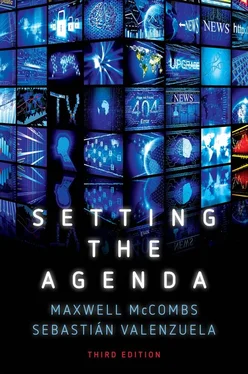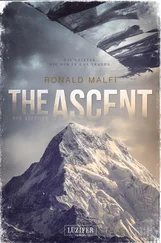The immediate origins of this idea began with a casual observation about the play of news stories on the front page of the Los Angeles Times one day in early 1967. There were three big stories that day: internationally, the unexpected shift from Labour to Conservative in the British county council elections; nationally, a budding scandal in Washington; and locally, the firing of the Los Angeles metropolitan area director of a large federally funded programme that was a keystone in President Johnson’s national ‘War on Poverty’. Not surprisingly, the Los Angeles Times put the local story in the lead position on page 1 and relegated the other two stories to less prominent positions on the front page. Any one of these stories – in the absence of the other two – easily would have been the page 1 lead, a situation that led to a speculative conversation over drinks among several young UCLA faculty members at their Friday afternoon ‘junior faculty meeting’ in the lobby of the Century Plaza Hotel. Is the impact of an event diminished when a news story receives less prominent play, we wondered? Those speculations grounded in a scattered variety of ideas and empirical findings about the influence of the media on the public were the seeds for the theory of agenda setting.
The formal explication of the idea of agenda setting began with my move that autumn to the University of North Carolina at Chapel Hill, where I met Donald Shaw and began what is now a fifty-year plus friendship and professional partnership. Our initial attempt at formal research on this idea built literally on those speculations in Los Angeles about the play of news stories. We attempted to construct an experiment based on actual newspapers that played the same story in radically different ways. The Charlotte Observer was a widely respected newspaper in North Carolina, which produced a series of editions during the day, early ones for points distant from Charlotte, the final edition for the city itself. One result of these multiple editions was that some stories would begin the day prominently played on the front page and then move down in prominence in subsequent editions, sometimes moving entirely off the front page. Our original plan was to use these differences from edition to edition as the basis of an experiment. However, the shifts in news play from day to day proved too erratic – in terms both of the subjects of the stories and in the way that their play in the newspaper changed – for any systematic comparison of their impact upon the public’s perceptions.
Despite this setback, the theoretical idea was intriguing, and we decided to try another methodological tack, a small survey of undecided voters during the 1968 US presidential election in tandem with a systematic content analysis of how the news media used by these voters played the major issues of the election. Undecided voters were selected for study on the assumption that, among the public at large, this group, who were interested in the election but undecided about their vote, would be the most open to media influence. This was the Chapel Hill study, now known as the origin of agenda-setting theory. 4
A fundamental contribution of the Chapel Hill study was the term itself, ‘agenda setting’, which gave this concept of media influence immediate currency among scholars. The late Steve Chaffee recalled that, when I saw him at the 1968 annual meeting of the Association for Education in Journalism and told him about our study of agenda setting, the term was new and unfamiliar but he immediately understood the focus of our research.
Since Donald Shaw was trained in history, you might expect us to have exact records on the creation of the term ‘agenda setting’ – the ‘One Tuesday afternoon in early August …’ kind of sentence – but, ironically, neither Donald nor I recalls exactly when we came up with that name. We did not mention ‘agenda setting’ in our 1967 application to the National Association of Broadcasters (NAB) for the small grant used in partial support of the research, but our 1969 report to the NAB on the results of the Chapel Hill study uses the term as if it had been around forever. Sometime during 1968 the name ‘agenda setting’ appeared, 5and Steve Chaffee undoubtedly was one of the first ‘referees’ to acknowledge its utility – perhaps the very first outside the immediate Chapel Hill circle involved in the project. Further corroboration is provided by the Google Books Ngram Viewer, which shows that 1968 was the first year in which the phrase ‘agenda setting’ was used systematically. Chapter 1presents the details of the Chapel Hill study as well as some of the key intellectual antecedents of this idea.
To paraphrase Sherlock Holmes, with the success of the 1968 Chapel Hill investigation, the game clearly was afoot. There were promising leads in hand for the solution to at least a portion of the mystery about the precise effects of the media upon public opinion. Subsequently, many detectives began to pursue these clues about how public attention and perception are influenced by the media and how various characteristics of the media, their content, and their audiences mediate these effects. Much like the adventures of Sherlock Holmes, whose cases fill nine lengthy volumes, a wide variety of links in this vast intellectual web has been chronicled. However, because the marketplace of ideas in communication research is very much one of laissez-faire, elaboration of the agenda-setting role of the communication media has not always proceeded in an orderly or systematic fashion. There have been many detectives working on many cases in a variety of geographical and cultural settings, adding a bit of evidence here and another bit there over the years. New theoretical concepts explicating the idea of agenda setting emerged in one part of this intellectual web, then in another.
For many years, the primary emphasis was an agenda of public issues. Especially in its popular manifestation of polls in the news media, public opinion is frequently regarded in these terms. Agenda-setting theory evolved from a description and explanation of the influence that the news media have on public opinion about the issues of the day. An open-ended question used by the Gallup Poll since the 1930s, ‘What is the most important problem facing this country today?’, is frequently used for this research because polls based on this question document the hundreds of issues that have engaged the attention of the public and pollsters over the decades. 6Perhaps for the first time in modern history, in 2020 this Most Important Problem (or MIP) question yielded the exact same response in all polls across the world: the coronavirus crisis.
Moving beyond an agenda of issues, agenda-setting theory has encompassed public opinion about political candidates and other public figures, specifically the images that the public holds of these individuals and the contributions of the media to those public images. This larger agenda of topics – public figures as well as public issues – marks an important theoretical expansion from the beginning of the communication process, what topics the media and public are paying attention to and regard as important, to subsequent stages, how the media and public perceive and understand the details of these topics. In turn, these stages are the opening gambit for mapping the consequences of the media’s agenda-setting role for attitudes, opinions, and behaviour.
And, in recent decades, investigation of agenda-setting effects and their consequences have expanded beyond the domain of public affairs to explore settings as diverse as sports, religion, and business. All of these media effects upon the public are presented in this volume, not just theoretically, but in terms of the empirical evidence on these effects worldwide.
Читать дальше












